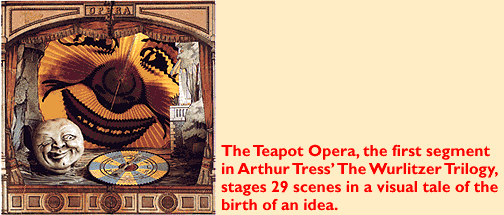IT MAY NOT be what the Wurlitzer company had in mind, but its carefree name suggests the whirl of the carousel, the pump of the pipe organ, a blur of music and color and a rollicking good time.
California photographer Arthur Tress has used the company's evocative name for his huge body of work now showing at the Center for Creative Photography. The Wurlitzer Trilogy consists of more than 100 color works whose dense dancing imagery has all the exuberance and pathos of the carnival. The silver dye bleach photos are divided up into three series that are as much as about Tress' written text as they are about his lush visuals, all silver dye bleach photos.
Brooklyn born in 1940 (did he frequent Coney Island?), Tress began the series in the early 1980s. It's unclear how much of it was planned in advance, but the way it's unfolded the trilogy neatly divides into themes and time periods. The first, The Teapot Opera, is photographed entirely inside an exquisite paper theatre, a child's toy dating from Victorian times, complete with paper curtains and elaborate backdrops of castles and snow-covered lands. On the theatre's stage Tress has placed his chatchkas, goofy thrift-store finds such as a marble Teddy Roosevelt head and a folding paper sun. The changing chatchkas in the 29 pictures tell the tale visually; a magical text that could have been lifted from a children's story tells it literarily.
The story is a romantic narrative about the birth of an idea, presumably an artistic notion, in the head of a "magician," presumably an artist. "Then all of a sudden a teapot appeared" begins the tale, in words inscribed under the picture of a white and pink flowered teapot on the stage. The unlooked-for teapot--or idea--changes and develops by means of a journey into fantastic regions, eventually getting contemptuously condemned by a court and carted off by police. In the end, the crestfallen magician realizes that "our darkest griefs may hold our brightest hopes. Soon he departed on another track." This text accompanies a beautiful metaphorical photograph. The objects on the stage, a stopwatch and tracks, form a glistening, serene still life. The backdrop is a lovely watercolor of one of those European train stations with translucent roofs and tracks winding optimistically off into the distance.
The old-fashioned tale, about the persistence of artists in the face of failure and rejection, doesn't fail to charm. But the next two portions of the trilogy deal with more difficult subject matter. Part Two is Fish Tank Sonata: An Ecological Fantasy in Five Parts, which Tress worked on from 1988 to 1990 with the aid of an NEA grant. Tress' framing device this time around, instead of the paper theatre, is an old glass aquarium, the kind that household goldfish regularly live and die in. The 53 pictures in this section are a present-day meditation on nature, on political and military tyranny, on man's inhumanity to man and to the earth.
 The aquarium's been placed in a variety of gorgeous outdoor settings,
on Catskill lakes, on Adirondack peaks, in meadows and on beaches.
There's a whole new cast too: a huge and threatening German soldier's
face, fish gobbling up tiny plastic humans, a gentle Einstein
head gone to flowers. Often the pictures are beautiful renditions
of the land and waters, with long perspectives into the distance
that come as a relief after the small world of the paper theatre.
The lovely final picture has a sailboat in the shallows at Provincetown,
the light glancing off its mast. But in this section the text
is often obscure and demanding.
The aquarium's been placed in a variety of gorgeous outdoor settings,
on Catskill lakes, on Adirondack peaks, in meadows and on beaches.
There's a whole new cast too: a huge and threatening German soldier's
face, fish gobbling up tiny plastic humans, a gentle Einstein
head gone to flowers. Often the pictures are beautiful renditions
of the land and waters, with long perspectives into the distance
that come as a relief after the small world of the paper theatre.
The lovely final picture has a sailboat in the shallows at Provincetown,
the light glancing off its mast. But in this section the text
is often obscure and demanding.
The final phase, Requiem for a Paperweight, chronicles the rise and fall of a hapless businessman, an anonymous paper pusher represented by a rigid plastic figure. The computer-inspired imagery here is futuristic and dreamy, in contrast to the sharp precision of the little theatre images and the Fish Tank shots of light in nature. The man is drifting through timeclocks and elevators in richly colored pictures suffused with found imagery. There are headlines touting the brave new future of technology and headlines detailing corporate greed and massive unemployment. Completed between 1991 and 1994, the work is a troubling essay about the uncertain place of people in a high-tech future that's already here.
If Tress' work sounds bizarre, well, it is, and its weirdness is heightened by the display of his little objects on shelves around the gallery. (You can play a game of locating the real-life junk in the pictures.) Yet it all works somehow. The ideas that Tress presents are not exactly original. But what is original is the extraordinary way he's used ordinary lumpen objects to dissect the most lofty of notions, and transformed them into pictures of lush beauty.
Arthur Tress: The Wurlitzer Trilogy continues through September 10 at the Center for Creative Photography on the University of Arizona campus. Gallery hours are 11 a.m. to 5 p.m. Monday through Friday, noon to 5 p.m. Sunday. Photographer Duane Michaels, a Tress colleague, will deliver talks at 5:30 p.m. August 24 and 25. Tress himself will give a gallery talk at 6 p.m., Friday, September 8, following a reception. For more information call 621-7968.





